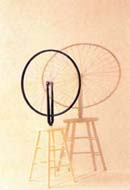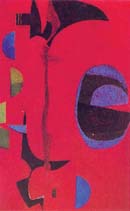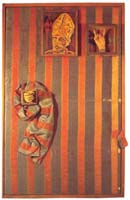A shortfall of research studies on the continental arts is the theoretical context poet Octavio Paz’s critical contribution hinges on. During the First Iberian American Meeting of Art Critics and Fine Artists in Caracas back in June 1978, expert Marta Traba said that only seven overview texts on the Latin American arts had been written up to that moment.
Three decades later, I don’t believe the situation hasn’t changed that much. I’m induced to that line of reasoning by the remarks of another renowned scholar, Federico Morais (1990: 8). In an embracing text on the continental arts, he came up with a new list of volumes that eventually proved Traba’s point right once again. Seeing eye to eye on this issue, let me quote Mexico-based Peruvian theoretician Juan Acha (1991: 33): “Maybe the most important problem the visual arts of the Americas are facing off today is the lack of an autonomous visual thinking they can nourish on and get renewed through. Because that autonomy ought to be the mandatory first step in our efforts toward artistic independence and the corresponding esthetic self-determination.”
If we add the close dependence the visual theme had on Latin America’s pure literary realm all through the 20th century –something which is not hard to prove at the library– it could be perfectly right to admit the equally close ties in our hemisphere between literature and the world of the fine arts or the visual scene. For just another expert and artist, Pablo Helguera (2003, 1), there’s been a vital need to look into those ties in Latin America because “writers became a paramount force in the making of cultural-supported models.”
Paz was fully aware of this situation as he uttered time and again that “the review of the poets was part of the history of Mexico’s modern arts.” So, I think it’s time now to get a crack at some sort of conceptualization on his “poetic review of the arts.”
Perhaps the starting point is in the writings of Ortega y Gasset, texts that have made those interested in the topic wiggle room for meditation –always on the basis of considering them the harbingers of the continental art review. In The Dehumanization of Art, Ortega (1935: 57) offers a follow-up guideline when he says: “Expressionism, cubism, etc., have been in a variety of degrees attempts to prove this resolution in the radical direction of the art. From the painting of things we have moved to the painting of ideas. The artist has turned a blind eye at the outer world and has kept an eye on the inner and subjective scenery.” Ortega’s Kant-inspired thesis leads to the belief that art interpretation may and should generate simultaneous or parallel stigmas to those of the visual arts, an open field for art review that, in his own words, is available “to imagine hypotheses that can explain them away, that can interpret them.”
At the same time, Pablo Helguera (2003: 67) says:
In practical terms, the esthetic discourse could be applied in such a way that the literary mindset –that comes to rescue the philosophical one- is revealed as a tacit decoder of the plastic meditation. Such a perception gives way, of course, to a huge interpretative freedom writers embark on to address their works, thus creating a hybrid genre that stands somewhere between poetic review and meditation.
It’s right at this point when the job of The Contemporaries in Mexico, proceeded by Jose Vasconcelos’ telluric writings and followed by Justino Fernandez’s Prometheus in 1945, paved the way for the appearance of three literary creators that make up the poetic review of the arts: Luis Cardoza y Aragon, Jose Lezama Lima and Octavio Paz.
The poetic review that started to arise with Cardoza y Aragon, Lezama and Paz lacks any methodological foundation in very pejorative terms,1 something that favored preference toward a kind of literary expression in which the critic’s impressions –direct, emotive, cultivated and to a large degree related to his personal liking– prevail over theoretical and academic considerations. Intertwined with other such disciplines as philosophy, sociology and psychology, this way of dealing with the arts did pay heed to the beauty of the language, usually based on the poetic inspiration of the images.
Breaking gradually away from the Euro-centrist viewpoint and relying on a symbolic creation stripped of profound academic studies, these critics didn’t intend to beget theories or classification concepts, but rather think of the art phenomenon and its processes, ranging from highly literary images –feeding on a considerable humanistic density– to a poetic image that acts as a mediator between the work of art and the reader. This process prompted the establishment of a literary creation with values of its own that zeroes in on the arts, a review capable of questioning painting, of finding and deciphering enigmas by creating new ones, of generating a new artistic nature from the perception of poetry, good enough to come up with a hermeneutics.
A review that scorned formality, that is, the simple enunciation of values and shortcomings of the reviewed object, and that could do without the simple domain of the translatable with a view to produce a new episteme. As Lezama referred to the animism and the reminiscent reasoning as ways to spawn a creative review based on new logos of the imagination, Paz wondered how to write on the arts without abdicating the reason, without turning it into a servant of the poet-critic’s liking. Before Paz ever asked himself that question, Cardoza (1987: 149) seemed to have the answer when he said: “We must be wise enough so as to even distrust our intelligence.”
In the case of Paz, we must recall his profession of faith expressed in “The Bow and the Lyre” (Complete Works, I: 232): “Truth does not stem from reason, but from poetic perception, that is, from imagination […] man is imagination and desire,” an axiom I believe it also fits in the cases of Lezama and Cardoza. The three of them bowed to the unfathomable heftiness of their own styles and languages, so different and personal, and they agreed on approaching the artistic development from all the senses, capturing the work’s emanating palpitations and deploying their meditations on pieces of heightened poetic prose. Senses, doubt and imagination closely imbricated to the artistic processes. That was their shared attempt they were committed to as independent writers. However, and resisting to the temptation of going deeper into this topic –something Dr. Adelaida de Juan has written abundantly– it’s necessary to point out that Jose Marti was just one of those forerunners, together with Baudelaire, who began appreciating the arts from a poetic line of thinking.
On pre-Hispanic art, Paz conducted an exercise of visual archeology in a bid to bring the arts and the Mesoamerican civilizations to an updated and erudite understanding heavily hooked up with his own studies on Mexican literature. When I refer to his erudite glance on this particular issue of the pre-Hispanic civilizations in Mesoamerica, I mean that Paz started from a review of all previous research studies carried out by other authors. That includes his opinions on the works of experts like Nigel Davies on the Toltecs and his description of the book entitled The Blood of the Kings. Dynasty and Ritual in Maya Art, by U.S. art historians Linda Echele and Mary Ellen Miller. But his immersions into the Mesoamerican art as a whole, written for the catalogs of major exhibitions mounted outside of Mexico, were the part of Paz’s studies on this topic that reached dramatic importance within his work as an essayist.
His leaning toward anthropological studies is made clear in the text entitled “The Art of Mexico: Matter and Sense” (1987: 39-58), in which Paz started out on the meaningfulness of the statue of goddess Coatlicue, discovered and dug out in 1790 while a number of municipal works were underway in Main Square of the Mexican capital. The fact that he considers the goddess a religious token, a demon, a monster and finally an artwork illustrates –from his own perspective the “progressive secularization mo-
dernity is characterized by.” Paz’s poetic prose shows the way that in the span of four centuries took the goddess from the shrine to the museum, but not without making a necessary warning: what we call today an artwork, a Western construction that emerged in the Renaissance period, was an equivocal designation for the ancient civilizations because what it actually stands for is “a configuration of signals.” This symbolic plurality is, according to Paz, the one thing that gives this statue such a profound cultural connotation.
When Paz avers that art lives out the societies that created it, he’s offering at the same time the stone-cold reality of those civilizations: architecture, statues and other artistic or religious creations, like bridges to gain access to a culture of translation from the past, that’s a transmutation or a metaphor of the original. In traipsing down this road all the way to the profound modification of the vision the Mexicans had about their past, he points at the values of the Mexican Revolution. To illustrate the way the present revisits the past, he quotes Lopez Velarde when he wrote that Mexico was discovering itself as “a Castilian and Moorish land with Aztec stripes.”
In the Western esthetic civilization, Paz conjugates facts that allow for a new vision of Mexicans about their history and culture: chronicles of the Spanish and Portuguese missionaries and sailors, the admiration of the Jesuits for the Chinese civilization, the philosophers of enlightenment, the fascination of the German romantics for the Sanskrit and the Hindu literature, “to the modern esthetic consciousness by the turn of the new century. Throughout this process, we discover the arts of Africa, the Americas and Oceania. The modern art from the West that has taught us to appreciate either a black mask or a Polynesian fetish, showed us the way to understand Mexico’s ancient art.” And he concludes: “Thus, the otherness of the Mesoamerican civilization is worked out on the opposite side of it: thanks to modern esthetics, to those distant works that are also contemporary.” (O. C., VII: 46) This sort of recycling or temporary game is commonly seen in his essays. Paz makes use of his erudite comprehension of the processes to establish interconnections in time and in the cultures.
His panorama touches on important elements in the relationship between the present and the Mesoamerican civilizations, between the sensitivity of some and the symbols of others. He asserts this art is a logic of the forms that is rendered in a cosmology, differentiating them from the culture in the forms of the Hellenic tradition derived from the Renaissance that, as we all know, banked on the representation of the human body.
After that he establishes the necessary differences that tell the Mesoamerican art from the one in New Spain and Mexico, along a review that considers the 16th century the period of the great destruction and, at the same time, of construction, and the 17th century the span of time when an architecturally transmuted and richer Spanish baroque was adopted. Down this road we get to Mexico’s popular art, a vague denomination that points at the Neolithic Era as the origin of a tradition that remains today. The texts ends with a new and imaginative extrapolation: Mexico and Flanders are considered two cultural ends of Spain.
In his quest on the pre-Hispanic cultures and arts, he makes constant distinctions among the Olmec –belonging to Teotihuacan– the Mayan and the Aztec. Yet in the course of this differentiating process he intends to settle the things that draw them closer and even bind them together somehow. The far-reaching ex-
tensions he makes as he remembers Coatlicue in Kali, Hutzilopochtli and Mix-
coatl in Krisna are memorable, and so are the ones he resorts to as he recognizes the splendorous Mayan culture in Polinawara and Angkor –phenomena derived from the a basic human communion and the nonstop tracings of its pilgrimage around the world that have drawn the interest of many observers and experts. But from the standpoint of the researcher who tries to get his vision on the art in edgeways, he favors the how over the what. And this leads to this statement: “I realized that Modernity is not the novelty and that being entirely modern takes a comeback to the start of the beginning.” (O. C., VII: 29) This is no doubt the key to his searches in the Mexican art, both the pre-Hispanic and the modern.
Alberto Ruy Sanchez (1990), a close collaborator of Paz’s and an art critic, has made an interesting note: “his passionate and poetic discovery of Mexico’s ancient art ran somehow parallel to the reassessment the surrealist art used to make of the primitive arts, either African or Eskimo, for instance.” This is a firsthand indication that the poet’s studies were the result of individual researches, coupled with experiences of his restless social life, especially among the surrealists. By that time, Malraux’s writings on the art of Oceania and other peripheral regions, as well as his celebrated Imaginary Museum, were making the rounds across the world. A certain parallel between Paz’s and Malraux’s art-mapping efforts could be set up, establishing, of course, the corresponding differences between both.
Either way and empathies apart, Paz’s studies on the arts of his ancestors took a variety of forms of expression along their evolution because in his major essay on Lévi-Strauss’s work and structuralism (Paz, 1972: 34-35), the same figures that were made out from the visual thinking were examined as myths, and in both attempts the intellectual attitude was exactly the same: decoding the mysteries of Mexico’s ancient history –just another of his great obsessions.
Paz evokes the archeological ruins and the complex moodiness of those peoples in the same breath; their mentality, just like several commentators from this same area of art review pointed out in a research effort that verges on scientific inquiry –though it sometimes hides itself in the leafy glade of its poetic prose. But let’s not be deceived; there are plenty of specialized readings when it comes to writing his elaborate texts on this ancestral art. He considered himself the Mexican writer with the largest amount of texts about his country’s Mesoamerican pre-Hispanic art, and there’s no overdoing or equivocation in this assertion. Though Pellicer delved compulsively into the Olmec culture and art, Paz’s discourse was much vaster and deeper in terms of historiographic, anthropological and cultural elements. Another study –not this one- could examine the footprints the pre-Hispanic images left in Paz’s poetry. They were many and can be seen in determinants of his lyricism (“Sunstone”, “Hick Lady”, Petrified Petrifying” and “Obsidian Butterfly”, among others). Paz insisted on the fact that there are three origins of the modern art in his country: the revelation of its culture; the recognition of itself that brought along the revolution; and the dialogue –from a romantic viewpoint–the artists from the West started out with the art and the culture of other times and places, that is, “esthetic cosmopolitism,” as put in his own words.
But his opinions on the art made in Latin America and, above all the contemporary art in a general sense, is –from my own view– the most interesting part of the grand tour he made around Mexican engraving in one of his essays. Paz quotes, for a first and only time in his essay volumes on art, a book on art review, Plastic Adventure of Hispanic America by Damian Bayon, when airing his views on Jose Guadalupe Posada that matches those of the Argentine critic. However, there’s one exceptional consideration he makes because we don’t know much about his readings on art review –there were probably too many based on his erudition– and that the Mexican poet gobbled up and assimilated in the course of his comprehension of these topics. At the end of that text, Paz points at some of the features that, in my opinion, set the tone of the art he experience: the fast pace new artistic trends show up and expand; the turn up in the air and on themselves by the avant-gardes, and the confusion of avant-garde trends, fashions and shams. He comes to a close underscoring the paradox and the great contradiction of the contemporary art (a term used herein exclusively in its temporal meaning): use and abuse of terms like avant-garde and subversion, while their acts and works verge more on the fashionable than on any other revolutionary form of art, thus generating a fascination and wrongness at the same time, and demonstrating the constitutional disease it suffers from. This leads it to be –according to him- “the living image of death.” Thanks to that illness –he says- it’s impossible to predict “whether contemporary art will win it strength back or it’ll be downgraded to barren repetitions, as it has happened in recent years,” (O. C., VI: 306-314) and he comes up with his own recipe to make it get its moxie back: the rediscovery of the convergence point (conjunction of the opposites) between tradition and invention.
Paz characterizes the Latin American art as an entity impossible to define, and then he speaks of the richness of that art, in flagrant contradiction with the abovementioned simplifying definition. The Mexican poet writes (O. C., VI: 306-314):
Like those form the other continents, our (art) is deployed through a multitude of contradicting trends and personalities. The difficulty to define this situation does not stem from the lack of styles, but rather from the abundance of them. Though the diversity of schools, ways and individual arts forbids any kind of generalization, there’s something each and every one of these contradicting forms shares: the spirit that encourages them.
And he ends by saying that being Latin American means:
knowing we are –in the form of memory or nostalgia, of hope or damnation– from this land and from other land. The Latin American art lives off and for that conflict. Its finest works, either in literature or the fine arts, are the response to that really unique condition unknown to the Europeans, the Asians or the Africans. The Latin American cosmopolitism is not a separation, just like nativism is not provincialism. We’re doomed to find the other land in our land; our land in the other land. This damnation can be sometimes worked out by means of creative freedom: that handful of unique works that have been created by a handful of Latin Americans so far this century.
The accurate and profound conception of our American lands allowed Paz to conclude his aforesaid text on Latin American engraving –in which he laid bare a few contradictions- by outlining his idea about “the end of modern art” and wrapped it up with a suggestive description of our art, the Latin American art.
Havana, May 2009
BIBLIOGRAPHY
Acha, Juan: “Toward an independent visual thinking”, in Toward an American theory of the arts, Anthropological Series, Ediciones del Sol, Buenos Aires, 1991.
Bayon, Damian: Plastic Adventure of Hispanic America, FCE, Mexico, 1975.
Cardoza y Aragon, Luis: “Art & Review”, in Anthology, SEP, Mexico, 1987.
Helguera, Pablo: “The roads of poetic critic in the Latin American art”, in Columna de Arena, March 12, 2003, on www.universe-in-universe.de, also excerpted from Arte al Día Bulletin, from CNAP n. 80, July, 2003.
Morais, Federico: “The fine arts in Latin America: the trance of the transitory”, Casa de las Américas, Havana, 1990.
Octavio Paz: Complete Works, 14 volumes, Economic Cultural Fund, Mexico D.F., 1994.
__________: Claude Lévi-Strauss or the Aesop’s new feast, Joaquin Mortiz, Mexico, 1972, pp. 34-35.
__________: The privileges of the sight. Mexico in the work of Octavio Paz, FCE, Mexico D.F., 1987.
Ortega y Gasset, Jose: The dehumanization of art, Occidente magazine, Madrid, 1925.
Ruy Sanchez, Alberto: “Itinerary of a look”, in The privileges of the sight, book-catalog, Cultural Center for the Contemporary Arts, Mexico, 1990.
Traba, Marta: “The tradition of the national” (work paper), in Catalog of the Museum of Contemporary Arts, Caracas, 1978.




Previous publication First Chile Triennial. Scouting the boundaries
Next publication Vernacular architecture in Caracas
Related Publications

How Harumi Yamaguchi invented the modern woman in Japan
March 16, 2022
Giovanni Duarte and an orchestra capable of everything
August 26, 2020











